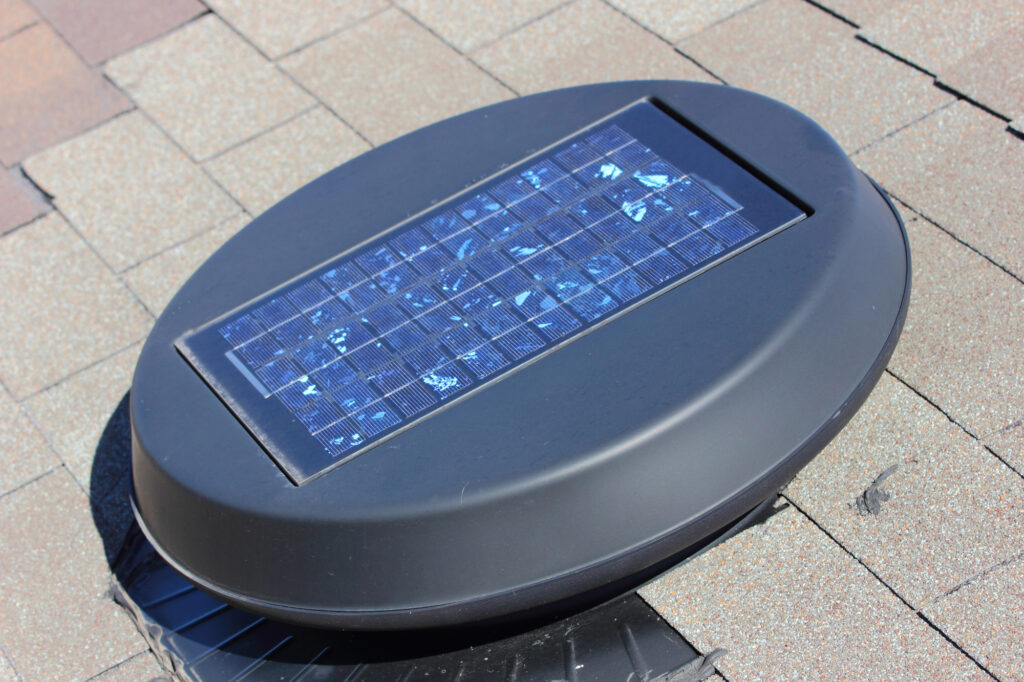Understanding the different types of attic ventilation can help you make a selection that aligns with your personal preferences and your home’s needs. Since many roofing and attic vents serve the same primary purposes, familiarity with the nuances of each different type of ventilation can help you customize the right system for your home in collaboration with a professional roofing ventilation company. For those looking to maximize their energy efficiency through temperature management and renewable energy operation, a solar attic vent may be the perfect solution!
Solar Attic Vent FAQ
Each type of roof vent comes with a few standard models as well as options for additional features. To help understand the basics of solar attic vents, which are sometimes also referred to as solar roof vents or solar-powered attic vents, the following addresses many common questions.
What is a solar-powered attic vent?
Heat and humidity often build up in the attic. For optimal air quality and circulation, as well as energy efficiency and temperature and moisture management, ventilation is essential. In conjunction with other roof vents, solar attic vents support the overall environment in the home, contribute to roof health, while potentially helping to reduce monthly energy expenses. Solar-powered attic fans can be installed directly on the roof or located on the gable. Some solar roof vent selections leverage a hybrid approach to power, so that vents can use converted energy from the sunlight when available and conventional electricity during stormy weather or nighttime hours.
How does a solar roof vent work?
There are two basic parts to the solar roof vent: the solar panels and, typically, a fan. The solar panels may be separate from the vent or integrated as a standalone unit to maximize exposure to the sun and convert it into electricity. The fan inside the vent housing is then powered by the available electrical energy. During its operation, the fan removes hot, moist air and other pollutants from the area underneath the roof.
What are the benefits of a solar attic vent?
Any thoughtfully-designed attic ventilation system has several advantages including improving air circulation, reducing the potential for mold growth and damage to insulation or the roofing structure, and temperature regulation. However, the inclusion of a solar attic vent comes with additional benefits, such as:
- Use of the sun as a renewable energy source makes this type of ventilation a more environmentally-friendly option.
- Reduced reliance on standard electricity may mean lower bills and continued service, even if there are power outages in the area.
- Solar attic vents are often less complex in design than other vent systems that utilize power sources, which can make them a lower-maintenance, longer-lasting option.
- Compared to other vents using electricity, solar vents may be easier to install, because they don’t require electrical wiring.
Strategizing Solar Roof Vent Installation
In creating the optimal ventilation system, the location of your home, the design of your roof, and the size of the attic can all impact your choices. For solar attic vent installations, let’s explore why these specific elements need to be considered.
- Attic size: Some homes have transformed attic areas into additional living spaces, while others may have minimal room to move in that space. Accordingly, the number of vents and their placement depends on the size of that space. How well-insulated the attic is can also influence ventilation system design.
- Location: How many hours of sunlight does your home typically enjoy? Do you live in a climate where warmer temperatures are more often the norm than cooler or more moderate temperatures? How much of your roof is regularly exposed to sunlight? Your answers to these questions may help inform whether or not a solar attic vent is appropriate for your home.
- Roof Design: To leverage the power of the sun, the solar panels powering the attic vents need to have the most consistent and frequent exposure to sunlight. Consequently, their placement on the roof and the angle at which they are installed require some strategizing for maximum access. Both how your roof is oriented in relation to the sun and the roof pitch can impact sun exposure, so roofing experts will take these details into account when determining your overall ventilation system layout.
Ventilation contributes not only to a comfortable environment within the home but also to the lifespan of your roof. Especially in colder climates, ventilation systems that include attic fans, solar roof vents and gable vents, help safeguard the structural and environmental well-being of the entire home and prevent potential problems like roof leaks, mold, wood rot and ice dams. For assistance with your roofing ventilation design or to discuss a new roof, tell us about your roof, so the team at Ranch Roofing can start collaborating with you on your upcoming project!

